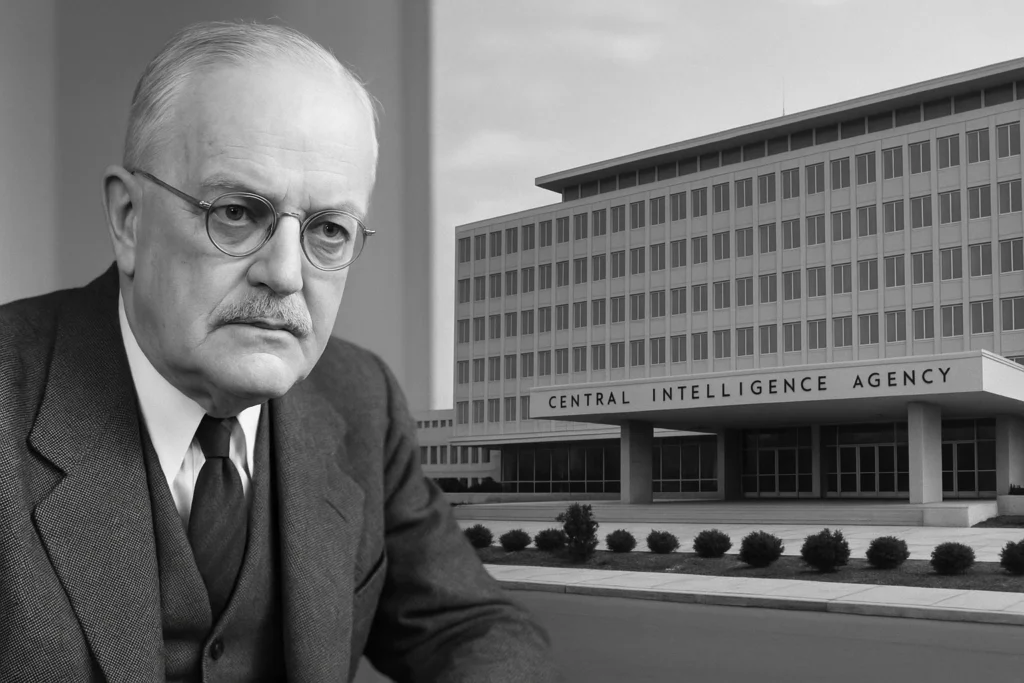In the shadowy corridors of Cold War espionage, the United States government embarked on one of its most disturbing ventures: Project MKUltra. Orchestrated by the CIA, this clandestine program was designed to unlock the secrets of the human mind—and weaponize them. What began as an effort to defend against perceived communist psychological threats soon morphed into an unchecked descent into human experimentation, manipulation, and suffering, often without consent [1][2].
For decades, the project remained hidden from the public eye. When the truth finally emerged, it didn’t just shock the conscience—it redefined the boundaries of state power and raised urgent questions about ethics, secrecy, and individual rights [3].

Meta: Shadowy CIA seal overlays blurred Cold War-era documents and agents—visually capturing the secrecy behind Project MKUltra and Cold War espionage.
The origins of MKUltra trace back to a time of intense geopolitical paranoia. In the early 1950s, the U.S. intelligence community became increasingly alarmed by reports that Soviet and Chinese operatives were developing techniques to control minds—whether through hypnosis, indoctrination, or drugs. These fears intensified following the Korean War, where American POWs exhibited signs of brainwashing [2].
In response, CIA Director Allen Dulles greenlit Project MKUltra in 1953 [1]. Its mission: to explore and perfect methods of behavior modification that could be used for interrogation, psychological warfare, and covert influence. Officially, it was about national security. In reality, it was a blank check for psychological experimentation—without oversight or accountability

Meta: Black-and-white AI-generated photo of CIA Director Allen Dulles with the 1950s Langley headquarters—capturing the era when MKUltra was born.
MKUltra was not a single experiment but a sprawling network of 149 subprojects, involving dozens of universities, hospitals, and research institutions—many of which had no idea they were under CIA contract [3][5]. The techniques explored were as innovative as they were inhumane.
LSD (lysergic acid diethylamide) became the crown jewel of the program. CIA operatives believed it could break down mental defenses and reveal hidden truths [1][2]. But it wasn’t just tested on volunteers. Unwitting civilians, prisoners, psychiatric patients, and even CIA employees were dosed with hallucinogens, often without warning or consent [3].
The chaos this caused was both literal and psychological. Some subjects suffered long-term psychosis, emotional breakdowns, or suicide [3]. The idea was to “depattern” the mind—to break it, and then rebuild it.

Meta: Close-up of a fake vintage LSD vial in a 1950s-style lab.
In one of MKUltra’s most bizarre and disturbing chapters, the CIA created makeshift brothels in San Francisco and New York under “Operation Midnight Climax” [2]. Sex workers on the CIA payroll lured men to these locations, where they were secretly dosed with LSD while CIA agents observed through two-way mirrors [3].
The goal? To study sexual behavior under the influence of mind-altering substances, hoping to refine techniques for blackmail or interrogation.
Perhaps the most grotesque subproject was Subproject 68, led by Dr. Ewen Cameron at Montreal’s Allan Memorial Institute. Under the guise of psychiatric care, patients—many with minor ailments—were subjected to “psychic driving”: endless loops of recorded messages played for days or weeks, combined with electroconvulsive therapy, drug-induced comas, and sensory deprivation [4].
Rather than healing minds, Cameron’s methods destroyed them. Many survivors lost basic memory functions, forgot how to speak or care for themselves, and never recovered [4].
For years, MKUltra thrived in silence. But cracks began to form in the early 1970s. As the Watergate scandal unraveled trust in government, investigative journalists and whistleblowers started to pull back the curtain on secret intelligence operations [2][3].
In 1975, the Church Committee and the Rockefeller Commission conducted landmark investigations into U.S. intelligence abuses. Their findings were explosive: MKUltra had violated domestic and international laws, used American citizens as test subjects, and destroyed vast amounts of evidence to cover its tracks [3].
Then-CIA Director Richard Helms had ordered the destruction of MKUltra files in 1973—but several boxes survived, giving investigators a window into the scale of the project [2][3].
Though MKUltra officially ended in 1973, its legacy lives on—as both a warning and a cultural obsession.
MKUltra’s exposure fueled a massive erosion of trust in government institutions. It became emblematic of how far agencies could go when left unchecked in the name of national security. In response, Congress passed laws to increase oversight of intelligence agencies, including the Foreign Intelligence Surveillance Act (FISA) in 1978 [2][3].
MKUltra has become a fixture in popular culture. It’s inspired countless books, films, and conspiracy theories—from The Manchurian Candidate to Stranger Things [2]. For many, it represents the terrifying question: What else haven’t we been told?
The scandal also forced a deep reckoning within medical and academic communities. The use of human subjects without informed consent is now strictly regulated under Institutional Review Boards (IRBs)—in large part due to the abuses seen in MKUltra [3].
Project MKUltra is more than just a dark footnote in American history. It is a powerful example of what happens when secrecy, fear, and unrestrained authority collide. It challenges us to ask:
As surveillance technology, neuropsychology, and artificial intelligence evolve, the ethical questions raised by MKUltra are more relevant than ever. If we forget these lessons, we risk repeating them.

Meta: Abstract circuitry forming a human brain—symbolizing MKUltra’s warning about surveillance, manipulation, and ethical decay in the digital age.
No filler. Just the good stuff, glazed with care.
No filler. Just the good stuff, glazed with care.